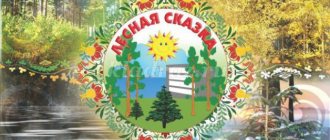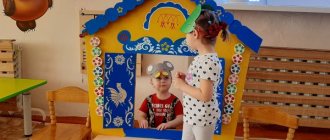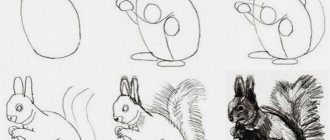Interactive presentation manual “Mushrooms”
Presentation "MUSHROOMS"
(for children of senior preschool age (5-7 years old))
Target:
formation in preschoolers of specific ideas about edible and inedible mushrooms, to distinguish them by appearance. Promote the development of cognitive interest.
The presentation can be used in classes, leisure activities (quiz games, KVNs, etc.), for conducting conversations.
Instructions.
The slides switch sequentially in accordance with the text of the conversation. At the beginning of the presentation there is a slide with picture buttons, with which you can optionally go to a description of a particular mushroom or to games.
On the slides describing mushrooms there are also buttons to return to the slide with picture buttons and a button to go to games.
The presentation offers interactive games (with triggers). The correctness of the answers is checked by “clicking” on the picture.
Slide No. 1 – title slide.
Slide number 2
Using the picture buttons on this slide (by clicking the mouse), you can go to a description of any of the mushrooms or to games.
Slide number 3
Educator.
This porcini mushroom, also called boletus, is the most desired find of a mushroom picker - beautiful, tasty, amazingly aromatic.
Slide number 4
Educator.
Guys, why do you think this mushroom is called white?
Children's answers.
Educator.
It got its name because of its pulp: it is white, does not change color when cut, and remains white both in dried and boiled mushrooms.
Slide No. 5
Educator.
The lower part of the cap of a young mushroom is white, but then becomes yellow-green. But the upper side of the boletus cap varies - from dark brown to light, almost white.
Slide No. 6
Educator.
The leg is short and thick, white or slightly brownish. The mushroom grows in spruce, pine and birch forests.
Slide No. 7
Educator.
The porcini mushroom is very beautiful and tasty, which is why all mushroom pickers have loved it for a long time.
Slide No. 8
Educator.
Among the porcini mushrooms there are real giants!
Using the hyperlinks at the bottom of the screen, you can return to the slide with picture buttons or go to the games.
Slide No. 9
Educator.
And this is a boletus. The top of its cap is orange, brown or red. That's why it is also called redhead. The bottom of the cap is gray.
Slide No. 10
Educator.
The leg of the boletus is thick and widens towards the bottom. Covered with scales, they come in white, gray, and black colors. The flesh of the mushroom quickly darkens when cut.
Slide No. 11
Educator.
It grows in deciduous and mixed forests, often in places where there are many young aspens. This is where it got its name. Found in large groups.
Slide No. 12
Educator.
Boletus is a very tasty mushroom. For any mushroom picker it is a welcome find.
Slide No. 13
Educator.
It is eaten boiled, fried, dried and pickled.
Using the hyperlinks at the bottom of the screen, you can return to the slide with picture buttons or go to the games.
Slide No. 14
Educator.
This is a boletus. It looks a little like both a porcini mushroom and a boletus. But its cap is softer, its leg is thinner and longer. When cut, the mushroom darkens a little.
Slide No. 15
Educator.
The color of the cap varies: from light gray to dark brown. This is a very common edible mushroom.
Slide No. 16
Educator.
The boletus can be found on the edges and hills, in places where there is enough solar heat and light. It grows singly and in groups. Many boletus can be found in young birch trees, hence its name. It is fried, pickled, and dried.
Using the hyperlinks at the bottom of the screen, you can return to the slide with picture buttons or go to the games.
Slide No. 17
Educator.
This is a flywheel. Moss mushroom is a mushroom with a velvety, dry or slightly sticky cap of golden brown, reddish or greenish color. The underside of the cap is yellow or yellow-greenish. The leg is smooth, sometimes slightly wrinkled.
Slide No. 18
Educator.
When cut, the mushroom quickly turns blue, but this does not spoil its taste. The moss mushroom is fried, salted, pickled, and dried. Why is the mushroom called that? Because it can often be found on the ground covered with moss.
Using the hyperlinks at the bottom of the screen, you can return to the slide with picture buttons or go to the games.
Slide No. 19
Educator.
Russulas are mushrooms that vary greatly in the color of their caps. They are pink, yellow, red, brown, greenish. There are white or yellowish plates on the underside of the cap. The stem is smooth and white.
Slide No. 20
Educator.
Russulas are very tender and brittle, and sometimes, by the time you bring them home, only crumbs remain, so not all mushroom pickers like to collect them. But despite this, russulas are very tasty.
Using the hyperlinks at the bottom of the screen, you can return to the slide with picture buttons or go to the games.
Slide No. 21
Educator.
This is a trumpet mushroom - an edible mushroom, widespread and very productive. The cap of the volnushka is pink or pinkish-red, with a curled, shaggy edge, and in the middle it is depressed and wet. The underside of the cap, like that of russula, is covered with plates.
Slide number 22
Educator.
If you break off a piece of mushroom, milk-white juice will appear on the break. Volnushki are salted, but before that they must be soaked in water to remove the bitterness. They can be eaten only a month after salting.
Using the hyperlinks at the bottom of the screen, you can return to the slide with picture buttons or go to the games.
Slide No. 23
Educator.
This mushroom is called bitter. Its cap is brownish-red. Both young and old mushrooms have a pointed tubercle in the center of the cap, and the underside is covered with plates.
Slide No. 24
Educator.
The pulp of the bitter is dense and brittle. When damaged, it produces bitter white juice. Bitters are salted and pickled. To remove bitterness, they, like volushki, are soaked in water.
Using the hyperlinks at the bottom of the screen, you can return to the slide with picture buttons or go to the games.
Slide No. 25
Educator.
This is a fly agaric. It is visible from afar. Its bright color with white spots attracts the attention of mushroom pickers. But everyone knows that it is poisonous to humans. But moose, deer, cows, goats and magpies eat this mushroom with pleasure.
Slide No. 26
Educator.
Even despite such a formidable name - “fly pest”, it does not seem to kill flies, but only intoxicates them. After some time, they come back to life again. The red fly agaric is one of the brightest and most beautiful mushrooms of the autumn forest.
Using the hyperlinks at the bottom of the screen, you can return to the slide with picture buttons or go to the games.
Slide No. 27
Educator.
This is a pale toadstool, it is considered the most dangerous poisonous mushroom. It can look different, most often it has a greenish cap and a white leg. Sometimes the pallid grebe is completely white.
Slide No. 28
Educator.
But it always has white plates under the cap, a white ring on the stem and a white torn sac at the bottom of the mushroom. The poison of the pale toadstool is not destroyed even when cooked. It affects internal organs unnoticed by a person within two days. And now I invite you to play!
Using the hyperlinks at the bottom of the screen, you can return to the slide with picture buttons or go to the games.
Slide No. 29
Educator.
Name the mushrooms you see on the screen?
The correctness of the answer is checked using a gramophone in the lower right corner of each picture (the name of the mushroom is heard).
Slide No. 30
Educator.
What are these mushrooms called?
The correctness of the answer is checked using a gramophone in the lower right corner of each picture (the name of the mushroom is heard).
Slide No. 31
Educator.
Name the mushrooms you see. Which one is the odd one out, and why?
The correct answer is checked using the mouse. When you click on an extra picture, it “fades”.
Slide No. 32
Educator.
Name these mushrooms. Which one is extra?
The correct answer is checked using the mouse. When you click on an extra picture, it “fades”.
Slide No. 33
Educator.
Name edible mushrooms.
The correct answer is checked using the mouse. When you click on edible mushrooms, they move to the basket.
7




